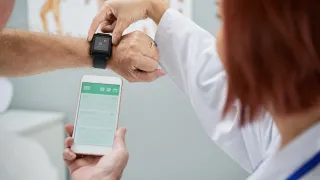I bet you didn’t know that before the invention of a modern chemical pregnancy test an African clawed frog was used. Poor frog was injected with the woman’s urine and if it started to emit spawn, the woman was declared pregnant. Since the invention of the chemical test in 1960s frogs have been left alone. First home tests were introduced in the 1970s. Home test is a significant innovation which enabled to reduce the number of expensive and time-consuming doctor visits.
Similar rapid tests can be used to measure other things as well. Technology starts to be mature enough to apply them in several domains. Good example is a saliva-based test which can be used to determine whether someone who has earlier consumed alcohol is in a condition to drive a car or not. Another example is to detect a bacterial infection from a blood sample.
VTT’s test and antibody development enables us to tailor tests for several topics. One potential application area is for example measuring vitamin D. Tests are also applied in environmental measuring. VTT, University of Turku, and Salofa have jointly developed a blue-green algae test. Salofa is commercializing this ten minute algae test and taking it abroad.
Refining tests into commercial products presupposes both cost-effective production and reliability from the product. VTT’s know-how in printing, chemistry, medicine, measurement, and communications technologies enables developing applications like this. VTT works in a user-centric way. Applications can be developed into almost ready products. After this companies can bring the commercialization further.
In addition to suitable price level and reliable functioning, a test application should be as easy to use as possible. Only this way it can have a shot to making it mainstream. This requires not only careful usability design, but also taking a holistic view and aiming to complete services. It makes sense to build a complete ecosystem around e.g. measuring blood samples. It should be possible to upload the results into a cloud service and even get consultation from a doctor or a nurse.
An inflammation measuring device connected to a mobile application released in 2017 was a step towards a complete service. Using this device elderly people can monitor themselves and contact healthcare professionals if needed. A potential next area could be wearables. An overweight person could diminish the risk of getting a cardiovascular disease if his/her vital signs were monitored and needed actions taken as early as possible.
When talking about future healthcare, digitalization is typically the proposed solution. Often things like telecommunications, mobile services, and doctor chats are in the core of the discussions. However, alone these are not enough; low-priced, reliable, and diverse sensors & measuring devices should also be available to consumers.
The modern pregnancy test reduced the number of doctor visits. Diverse and cheap instant tests can multiply this phenomenon. As the amount of routine consultation diminishes, doctors’ time can be allocated to more appropriate activities. This, in turn, can make the whole society healthier. An ambitious goal but in the light of current knowledge perfectly realistic!




